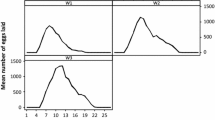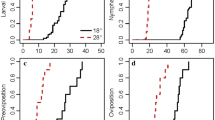Abstract
The present study aimed to evaluate biological parameters of Rhipicephalus microplus in the non-parasitic phase in both field and laboratory conditions. It also aimed to assess correlations between duration (in days) of these parameters and climatic variables (humidity, rainfall, and soil temperature) and to estimate the annual number of generations of R. microplus in a tropical region. The non-parasitic phase of R. microplus in field and laboratory conditions was evaluated throughout the course of two years. A pasture was infested with engorged female of R. microplus, and biological parameters, including female pre-oviposition, female oviposition, egg mass incubation, larval pre-hatching phase, larval maturation, and larval longevity, were evaluated concomitantly with the collection of data on climatic conditions. The same parameters were also evaluated in a climatized chamber in the laboratory. The total duration of the non-parasitic phase in the field was longer in the dry season (1st and 4th life-cycle repetitions) than in the rainy season (2nd, 3rd, and 5th repetitions). Tick biological parameters for the non-parasitic phase in the laboratory were similar to those obtained in the field during the rainy season. The evaluated biological parameters were influenced mainly by environmental and ground-level temperatures, which modified egg mass incubation, larval pre-hatching, and larval longevity periods and, consequently, the total duration of the non-parasitic phase of the tick. The annual number of generations for the tick was estimated at five per year, which is alarming because it represents an increase, and so new studies into strategic control are needed.



Similar content being viewed by others
References
Andreotti R, Garcia MV, Koller WW (2019) Carrapatos na cadeia produtiva de bovinos. Embrapa, Brasília
Araújo JV (1994) Controle estratégico experimental do carrapato de bovinos Boophilus microplus (Canestrini, 1887) (Acarina: Ixodidae) em bezerros do município de Viçosa, zona da mata de Minas Gerais, Brasil. Braz J Vet Res Anim Sci. https://doi.org/10.11606/issn.1678-4456.bjvras.1994.52068
Borges LMF, Carneiro JR, Gomes AG, Moreira PC (2001) Influência do peso inicial e da estação do ano na conversão em ovos de fêmeas de Boophilus microplus (Acari: Ixodidae). Ciência Animal Brasil 2:127–131
Brizuela CM, Ortellado CA, Sanchez TI, Osorio O, Walker AR (1996) Formulation of integrated control of Boophilus microplus in Paraguay: analysis of natural infestations. Vet Parasitol 63:95–108. https://doi.org/10.1016/0304-4017(95)00885-3
Brovini CN, Furlong J, Chagas ACS (2003) Influência dos fatores climáticos na biologia e no comportamento de fêmeas ingurgitadas de Boophilus microplus a campo. Biosc J 19:71–76
Burguer TD, Shao R, Barker SC (2014) Phylogenetic analysis of mitochondrial genome sequences indicates that the cattle tick, Rhipicephalus (Boophilus) microplus, contains a cryptic species. Mol Phylogenet Evol 76:241–253
Canevari JT, Mangold AJ, Guglielmone AA, Nava S (2016) Population dynamics of the cattle tick Rhipicephalus (Boophilus) microplus in a subtropical subhumid region of Argentina for use in the design of control strategies. Med Vet Entomol 31:6–14. https://doi.org/10.1111/mve.12199
Carneiro JR, Calil F, Panicali E, Rodrigues N (1992) Ocorrência de Ixodidae e variação estacional do Boophilus microplus (Can., 1888) em bovinos da bacia leiteira de Goiânia-GO. Rev Pat Trop 21:235–242
Cepagri (2017) Clima dos Municípios Paulistas—Jaboticabal. www.cpa.unicamp.br/outras-informacoes/clima_muni_279.html. Accessed 16 June 2017
Cruz BC, Lopes WDZ, Maciel WG, Felippelli G, Fávero FC, Teixeira WFP, Carvalho RS, Ruivo MA, Colli MHA, Sakamoto CAM, Da Costa AJ, De Oliveira GP (2015) Susceptibility of Rhipicephalus (Boophilus) microplus to ivermectin (200, 500 and 630 g/kg) in field studies in Brazil. Vet Parasitol 207:309–317. https://doi.org/10.1016/j.vetpar.2014.12.012
De Barros MNDL, Riet-Correa F, Azevedo SS, Labruna MB (2017) Off-host development and survival of Rhipicephalus (Boophilus) microplus in the Brazilian semiarid. Vet Parasitol Reg Stud Rep 9:17–24
Esteves E, Pohl PC, Klafke GM, Reck J, Fogaça AC, Martins JR, Daffre S (2015) Low temperature affects cattle tick reproduction but does not lead to transovarial transmission of Anaplasma marginale. Vet Parasitol 214:322–326
Estrada-Peña A (2015) Ticks as vectors: taxonomy, biology and ecology. Rev Sci Tech: Off Int Epizoot. https://doi.org/10.20506/rst.34.1.2345
Estrada-Peña A, Sánchez-Acedo C, Quilez J, Del Cacho E (2005) A retrospective study of climatic suitability for the tick Rhipicephalus (Boophilus) microplus in the Americas. Glob Ecol Biogeogr 14:565–573. https://doi.org/10.1111/j.1466-822X.2005.00185.x
Estrada-Peña A, Venzal JM, Nava S, Mangold A, Guglielmone AA, Labruna MB, De La Fuente J (2012) Reinstatement of Rhipicephalus (Boophilus) australis (Acari: Ixodidae) with redescription of the adult and larval stages. J Med Entomol 49:94–802
Evans DE (1992) Tick infestation of livestock and tick control methods in Brazil: a situation report. Int J Trop Insect Sci 13:629–643. https://doi.org/10.1017/S1742758400016234
Furlong J, Sales RO (2007) Controle estratégico de carrapatos no bovino de leite: uma revisão. Rev Bras Hig San Ani 1:44–72
Garcia MV, Higa LOS, Barros JC, Andreotti A (2016) Protocolos sobre bioensaios para diagnóstico da resistência de Rhipicephalus microplus aos acaricidas. In: Andreotti R, Koller WW, Garcia MV (eds) Carrapatos: protocolos e técnicas para estudo. Embrapa, Brasília, pp 179–194
Grisi L, Leite RC, Martins JRS, Barros ATM, Andreotti R, Cançado PHD, Leon AA, Pereira JB, Villela HS (2014) Reassessment of the potential economic impact of cattle parasites in Brazil. Rev Bras Parasitol Vet 23:150–156. https://doi.org/10.1590/S1984-29612014042
Hernández-A F, Teel PD, Corson MS, Grant WE (2000) Simulation of rotational grazing to evaluate integrated pest management strategies for Boophilus microplus (Acari: Ixodidae) in Venezuela. Vet Parasitol 92:139–149. https://doi.org/10.1016/S0304-4017(00)00282-X
Kasai N, Labruna MB, Pires AV, Louvandini H, Abdalla AL, Genari SG (2000) Dinâmica populacional de Boophilus microplus (Canestrini, 1887) em bovinos leiteiros mantidos em manejo de pastejo rotativo de capim-elefante. Arq Bras Med Vet Zootec 52:453–458. https://doi.org/10.1590/S0102-09352000000500008
Klafke G, Webster A, Dall’Agnol B, Pradel E, Silva J, De La Canal LH, Becker M, Osório MF, Mansson M, Barreto R, Scheffer R, Souza UA, Corassini VB, Dos Santos J, Reck J, Martins JR (2017) Multiple resistance to acaricides in field populations of Rhipicephalus microplus from Rio Grande do Sul state, Southern Brazil. T Tick-borne Dis 8:73–80. https://doi.org/10.1016/j.ttbdis.2016.09.019
Labruna MB, Leite RC, De Oliveira PR (1997) Study of the weight of eggs from six ixodid species from Brazil. Mem Inst Oswaldo Cruz 92:05–207. https://doi.org/10.1590/S0074-02761997000200012
Labruna MB, Naranjo V, Mangold AJ, Thompson C, Estrada-Peña A, Guglielmone AA, Jongejan F, De La Fuente J (2009) Allopatric speciation in ticks: genetic and reproductive divergence between geographic strains of Rhipicephalus (Boophilus) microplus. BMC Evol Biol 9:1–12
Labruna MB, Veríssimo CJ (2001) Observações sobre a infestação por Boophilus microplus (Acari: Ixodidae) em bovinos mantidos em rotação de pastagem, sob alta densidade animal. Arq Inst Biol 68:115–120
Leal B, Thomas DB, Dearth RK (2017) Population dynamics of off-host Rhipicephalus (Boophilus) microplus (Acari: Ixodidae) larvae in response to habitat and seasonality in South Texas. Vet Scie. https://doi.org/10.3390/vetsci5020000
Lima WS, Ribeiro MF, Guimarães MP (2000) Seasonal variation of Boophilus microplus (Canestrini, 1887) (Acari: Ixodidae) in cattle in Minas Gerais state, Brazil. Trop Anim Health Prod 32:375–380. https://doi.org/10.1023/A:1005229602422
Low VL, Tay ST, Kho KL, Koh FX, Tan TK, Lim YAL, Ong BL, Panchadcharam C, Norma-Rashid Y, Sofian-Azirun M (2015) Molecular characterization of the tick Rhipicephalus (Boophilus) microplus in Malaysia: new insights into the cryptic diversity and distinct genetic assemblages throughout the world. Parasit Vectors 8:341. https://doi.org/10.1186/s13071-015-0956-5
Maciel WG, Lopes WDZ, Gomes LVC, Cruz BC, Felippelli G, Dos Santos IB, Borges FA, Junior WAG, Scarpa AB, Nicaretta JE, Bastos TSA, Da Costa AJ (2016) Susceptibility of Rhipicephalus (Boophilus) microplus to fluazuron (2.5 mg/kg) and a combination of novaluron (2.0 mg/kg) + eprinomectin (0.36 mg/kg) in field studies in Brazil. Prev Vet Med 135:74–86. https://doi.org/10.1016/j.prevetmed.2016.10.019
Mastropaolo M, Mangold AJ, Guglielmone AA, Nava S (2017) Non-parasitic life cycle of the cattle tick Rhipicephalus (Boophilus) microplus in Panicum maximum pastures in northern Argentina. Res Vet Sci 115:138–145
Morel N, Signorini ML, Mangold AJ, Guglielmone AA, Nava S (2017) Strategic control of Rhipicephalus (Boophilus) microplus infestation on beef cattle grazed in Panicum maximum grasses in a subtropical semi-arid region of Argentina. Prev Vet Med 144:179–183. https://doi.org/10.1016/j.prevetmed.2017.06.006
Nava S, Mastropaolo M, Guglielmone AA, Mangold AJ (2013) Effect of deforestation and introduction of exotic grasses as livestock forage on population dynamics of the cattle tick Rhipicephalus (Boophilus) microplus (Acari: Ixodidae) in northern Argentina. Res Vet Sci 95:1046–1054. https://doi.org/10.1016/j.rvsc.2013.09.013
Oliveira GP (1979) Relação entre o peso da postura e o peso da fêmea ingurgitada de Boophilus microplus (Can.) (Acarina: Ixodidae). Científica 7:273–276
Oliveira GP, Costa RP, Mello RP, Meneguelli CA (1974) Estudo ecológico da fase não parasítica do Boophilus microplus (Canestrini, 1887) (Acarina, Ixodidae) no estado do Rio de Janeiro. Arq Universidade Federal Rural do Rio de Janeiro 4:1–10
Panda DN, Ansari MZ, Sahai BN (1992) Studies on the development and survival periods of the non-parasitic stages of Boophilus microplus (Canestrini), in the climatic conditions of Ranchi (India). Vet Parasitol 44:275–283
Pereira AA (2008) Aspectos ecológicos de Boophilus microplus (Canestrini, 1887) (Acarina: Ixodidae) no município de Franca, nordeste de São Paulo. 2008. 113 f. Tese (Doutorado em Medicina Veterinária—área de Patologia Animal)—Faculdade de Ciências Agrárias e Veterinárias, Universidade Estadual Paulista “Júlio de Mesquita Filho,” Jaboticabal
Perret JL, Guigoz E, Rais O, Gern L (2000) Influence of saturation deficit and temperature on Ixodes ricinus tick questing activity in a Lyme borreliosis-endemic area (Switzerland). Parasitol Res 86:554–557
Pfäffl M, Littwin N, Muders SV, Petney TN (2013) The ecology of tick-borne diseases. Int J Parasitol 43:1059–1077
Reck J, Klafke GM, Webster A, Dall’Agnol B, Scheffer R, Souza UA, Corassini VB, Vargas R, Dos Santos JS, Martins JRS (2014) First report of fluazuron resistance in Rhipicephalus microplus: a field tick population resistant to six classes of acaricides. Vet Parasitol 201:128–136. https://doi.org/10.1016/j.vetpar.2014.01.012
Rocha UF, Banzatto DA, Da Costa AJ, Galluzzi FD, Garcia MCC, Faleiros RB, Vidotto O (1985) Nova técnica de cubagem para estudo de correlações entre volume e peso de carrapatas e sua longevidade e prolificidade. Semina. 6:69–74
Roy BC, Estrada-Peña A, Krucken J, Rehman A, Nijhof AM (2018) Morphological and phylogenetic analyses of Rhipicephalus microplus ticks from Bangladesh, Pakistan and Myanmar. T Tick-Borne Dis 9:1069–1079
Santarém VA, Sartor IF (2003) Fase de vida livre e flutuação sazonal do Boophilus microplus em Botucatu, São Paulo, Brasil. Semin Cien Agrar 24:11–20
SAS Institute Inc (2002) Statistical analysis system user's guide. Version 9.0. Statistical Analysis System Institute, Cary, p 513
Statsoft, Inc. Statistica (data analysis software system), version 12. 2014. www.statsoft.com
Acknowledgments
Data on this paper are part of a Ph.D. thesis fully supported by the São Paulo Research Foundation (grant #2014/14820-2, São Paulo Research Foundation—FAPESP). CPPAR provided the infrastructure for this experiment. The authors would like to thank Drs. Marcos Valério Garcia, Marcos Rogério André, Darci Moraes Barros-Battesti, Cláudio Alesandro Massamitsu Sakamoto, and Claudinei da Cruz, for their extensive help in proofreading and correcting the article, the mentioned thesis.
Author information
Authors and Affiliations
Corresponding author
Ethics declarations
Conflict of interest
The authors declare that they have no conflicts of interest which may have biased the present work.
Additional information
Section Editor: Domenico Otranto
Publisher’s note
Springer Nature remains neutral with regard to jurisdictional claims in published maps and institutional affiliations.
Rights and permissions
About this article
Cite this article
Cruz, B.C., de Lima Mendes, A.F., Maciel, W.G. et al. Biological parameters for Rhipicephalus microplus in the field and laboratory and estimation of its annual number of generations in a tropical region. Parasitol Res 119, 2421–2430 (2020). https://doi.org/10.1007/s00436-020-06758-5
Received:
Accepted:
Published:
Issue Date:
DOI: https://doi.org/10.1007/s00436-020-06758-5




